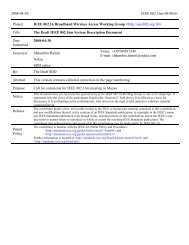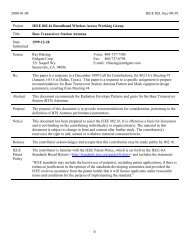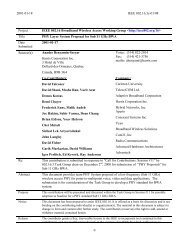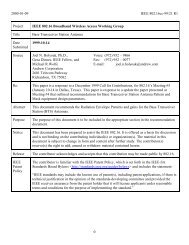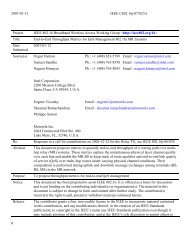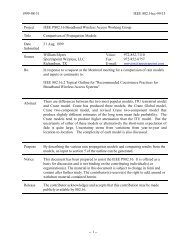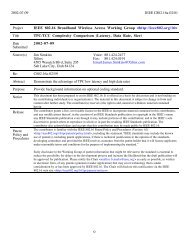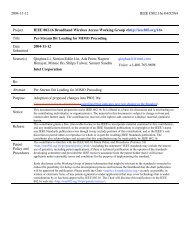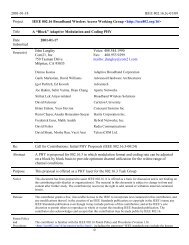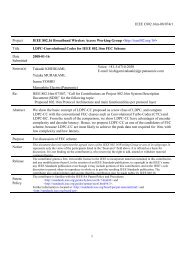802.16.1 Functional Requirements, Rev. 1 - LMSC, LAN/MAN ...
802.16.1 Functional Requirements, Rev. 1 - LMSC, LAN/MAN ...
802.16.1 Functional Requirements, Rev. 1 - LMSC, LAN/MAN ...
You also want an ePaper? Increase the reach of your titles
YUMPU automatically turns print PDFs into web optimized ePapers that Google loves.
1234567891011121999-12-17 IEEE 802.16s-99/00r1multi-tenant office building or dwelling. A base station interfaces to one or more core networksthrough one or more BNIs. For the purposes of <strong>802.16.1</strong>, the SNI and BNI are abstractconcepts. The details of these interfaces, which are sometimes called inter-working functions(IWFs), are beyond the scope of this document and are not specified by the forthcominginteroperability standard [20] [17]. Since many subscriber and core network technologies arepossible, many different IWFs are conceivable. The simplified reference model, serves to discussthe impact of core network technologies and bearer services (see section 3.1) on the requirementsof <strong>802.16.1</strong> protocols by drawing focus to the air interface and the immediate requirementsimposed by the surrounding networks. The standard (e.g., MAC/PHY protocols) SHALLdescribe common access protocol(s) and common modulation technique(s).SubscriberNetworkSNISSAirInterfaceBSBNICoreNetwork13SNI: SS Network InterfaceSS: Subscriber StationBS: Base StationBNI: BS Network InterfaceRepeater(OPTIONAL)14151617181920212223242526272829303132333435Figure 2-3: System Reference Points2.2 TopologySince all data traffic in a single cell of an <strong>802.16.1</strong> network MUST go through the base station,that station SHALL serve as a radio resource supervisor [10]. The subscriber stations mayrequest bandwidth to achieve QoS objectives (see section 6), but it may be convenient for thebase station to implement the “smarts” of bandwidth allocation.In the downstream direction, within a channel, the network topology is similar to a contentionlessbroadcast bus, since all transmissions are transmitted by the base station, and more than onesubscriber station could share a downstream channel. In the upstream direction, if subscriberstations share a channel, the topology is similar to a contention-oriented bus, <strong>802.16.1</strong> protocolsMUST provide the means to multiplex traffic from multiple subscriber stations in the downstreamdirection, and provide for a means to resolve contention and allocate bandwidth in the upstreamdirection.3 Supported ServicesThis section describes the bearer services that an <strong>802.16.1</strong> system at least SHOULD support(some services MUST be supported). First, typical target markets are described, then theparticular bearer services which an <strong>802.16.1</strong> system is expected to transport.It may be difficult to comprehend services the system supports without first understanding thesystem model. Please refer to section 2 if necessary.-7-



